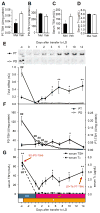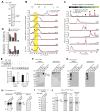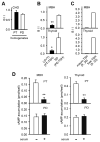Tissue-specific posttranslational modification allows functional targeting of thyrotropin
- PMID: 25437536
- PMCID: PMC4251493
- DOI: 10.1016/j.celrep.2014.10.006
Tissue-specific posttranslational modification allows functional targeting of thyrotropin
Abstract
Thyroid-stimulating hormone (TSH; thyrotropin) is a glycoprotein secreted from the pituitary gland. Pars distalis-derived TSH (PD-TSH) stimulates the thyroid gland to produce thyroid hormones (THs), whereas pars tuberalis-derived TSH (PT-TSH) acts on the hypothalamus to regulate seasonal physiology and behavior. However, it had not been clear how these two TSHs avoid functional crosstalk. Here, we show that this regulation is mediated by tissue-specific glycosylation. Although PT-TSH is released into the circulation, it does not stimulate the thyroid gland. PD-TSH is known to have sulfated biantennary N-glycans, and sulfated TSH is rapidly metabolized in the liver. In contrast, PT-TSH has sialylated multibranched N-glycans; in the circulation, it forms the macro-TSH complex with immunoglobulin or albumin, resulting in the loss of its bioactivity. Glycosylation is fundamental to a wide range of biological processes. This report demonstrates its involvement in preventing functional crosstalk of signaling molecules in the body.
Figures




Similar articles
-
Pars Distalis and Pars Tuberalis Thyroid-Stimulating Hormones and Their Roles in Macro-Thyroid-Stimulating Hormone Formation.Int J Mol Sci. 2023 Jul 20;24(14):11699. doi: 10.3390/ijms241411699. Int J Mol Sci. 2023. PMID: 37511458 Free PMC article. Review.
-
Thyrotropin expression in hypophyseal pars tuberalis-specific cells is 3,5,3'-triiodothyronine, thyrotropin-releasing hormone, and pit-1 independent.Endocrinology. 1997 Mar;138(3):1019-28. doi: 10.1210/endo.138.3.5007. Endocrinology. 1997. PMID: 9048604
-
Molecular economy of nature with two thyrotropins from different parts of the pituitary: pars tuberalis thyroid-stimulating hormone and pars distalis thyroid-stimulating hormone.Arch Med Sci. 2021 Jan 5;17(1):189-195. doi: 10.5114/aoms/102476. eCollection 2021. Arch Med Sci. 2021. PMID: 33488871 Free PMC article.
-
Seasonal Rhythms: The Role of Thyrotropin and Thyroid Hormones.Thyroid. 2018 Jan;28(1):4-10. doi: 10.1089/thy.2017.0186. Epub 2017 Oct 5. Thyroid. 2018. PMID: 28874095 Review.
-
Regulation of thyrotropin (TSH) bioactivity by TSH-releasing hormone and thyroid hormone.Endocrinology. 1986 May;118(5):2125-30. doi: 10.1210/endo-118-5-2125. Endocrinology. 1986. PMID: 3084213
Cited by
-
Glycosylation in the Thyroid Gland: Vital Aspects of Glycoprotein Function in Thyrocyte Physiology and Thyroid Disorders.Int J Mol Sci. 2018 Sep 17;19(9):2792. doi: 10.3390/ijms19092792. Int J Mol Sci. 2018. PMID: 30227620 Free PMC article. Review.
-
RFRP Neurons - The Doorway to Understanding Seasonal Reproduction in Mammals.Front Endocrinol (Lausanne). 2016 May 3;7:36. doi: 10.3389/fendo.2016.00036. eCollection 2016. Front Endocrinol (Lausanne). 2016. PMID: 27199893 Free PMC article. Review.
-
Homeostatic Control of the Thyroid-Pituitary Axis: Perspectives for Diagnosis and Treatment.Front Endocrinol (Lausanne). 2015 Nov 20;6:177. doi: 10.3389/fendo.2015.00177. eCollection 2015. Front Endocrinol (Lausanne). 2015. PMID: 26635726 Free PMC article. Review.
-
Mimicking seasonal changes in light-dark cycle and ambient temperature modulates gut microbiome in mice under the same dietary regimen.PLoS One. 2023 Feb 15;18(2):e0278013. doi: 10.1371/journal.pone.0278013. eCollection 2023. PLoS One. 2023. PMID: 36791094 Free PMC article.
-
Highly Sensitive O-Glycan Profiling for Human Serum Proteins Reveals Gender-Dependent Changes in Colorectal Cancer Patients.Anal Chem. 2019 May 7;91(9):6180-6189. doi: 10.1021/acs.analchem.9b00822. Epub 2019 Apr 24. Anal Chem. 2019. PMID: 30983323 Free PMC article.
References
-
- Aksentijevich I, Sachs DH, Sykes M. Natural antibodies against bone marrow cells of a concordant xenogeneic species. J Immunol. 1991;147:4140–4146. - PubMed
-
- Andersen S, Pedersen KM, Bruun NH, Laurberg P. Narrow individual variations in serum T4 and T3 in normal subjects: a clue to the understanding of subclinical thyroid disease. J Clin Endocrinol Metab. 2002;87:1068–1072. - PubMed
-
- Baensiger JU, Green ED. Pituitary glycoprotein hormone oligosaccharides: structure, synthesis and function of the asparagine-linked oligosaccharides on lutropin, follitropin and thyrotropin. Biochim Biophys Acta. 1988;947:287–306. - PubMed
-
- Baker BL, Yu YY. Hypophyseal changes induced by thyroid deficiency and thyroxine administration as revealed by immunochemical staining. Endocrinology. 1971;89:996–1004. - PubMed
-
- Beck-Peccoz P, Amr S, Menezes-Ferreira MM, Faglia G, Weintraub BD. Decreased receptor binding of biologically inactive thyrotropin in central hypothyroidism. Effect of treatment with thyrotropin-releasing hormone. N Engl J Med. 1985;312:1085–1090. - PubMed
Publication types
MeSH terms
Substances
Grants and funding
LinkOut - more resources
Full Text Sources
Other Literature Sources
Miscellaneous

